Supply Chain Management: Integration & Globalization at Magnit Group
VerifiedAdded on 2023/06/03
|63
|13423
|275
Report
AI Summary
This research report delves into the complexities of supply chain management (SCM) within the Magnit Group, a prominent grocery retail company in Russia, with a specific focus on integration and globalization in the context of e-business. The study investigates various aspects of SCM, including material quality, supplier evaluation, logistics, inventory management, and procurement practices. It emphasizes the importance of a continuous flow of goods for business effectiveness. The literature review covers SCM, Sales Operating Plans, e-business, and collaborative systems, highlighting the need for managers to proactively address risks. The research methodology involves survey questionnaires and interviews with Magnit Group employees and managers to gather data on specific areas of the research topic. The findings suggest that the company needs to improve aspects of product delivery and quality from suppliers and enhance communication mediums for better supply chain integration. The report concludes by recommending a focus on workforce optimization for long-term business profitability.
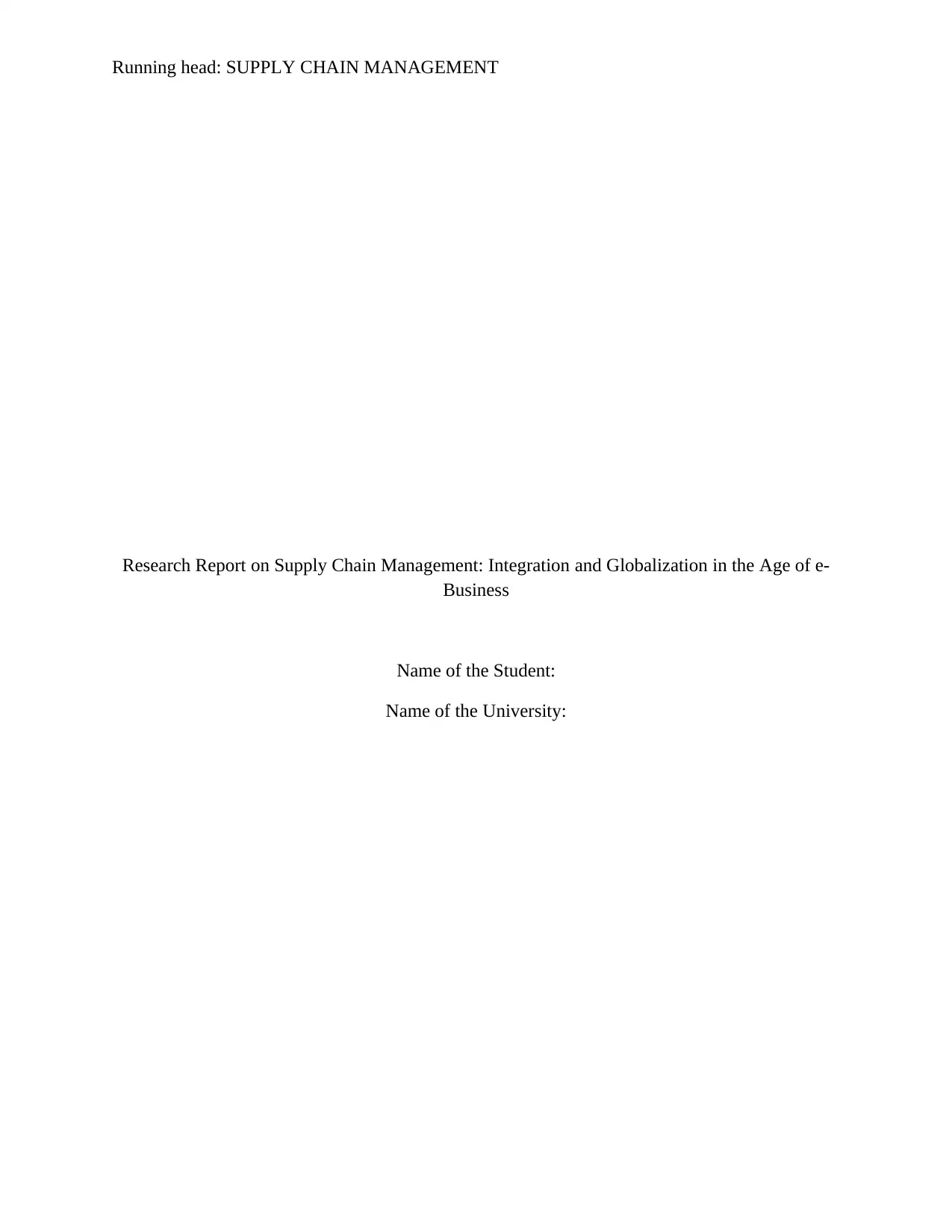
Running head: SUPPLY CHAIN MANAGEMENT
Research Report on Supply Chain Management: Integration and Globalization in the Age of e-
Business
Name of the Student:
Name of the University:
Research Report on Supply Chain Management: Integration and Globalization in the Age of e-
Business
Name of the Student:
Name of the University:
Paraphrase This Document
Need a fresh take? Get an instant paraphrase of this document with our AI Paraphraser
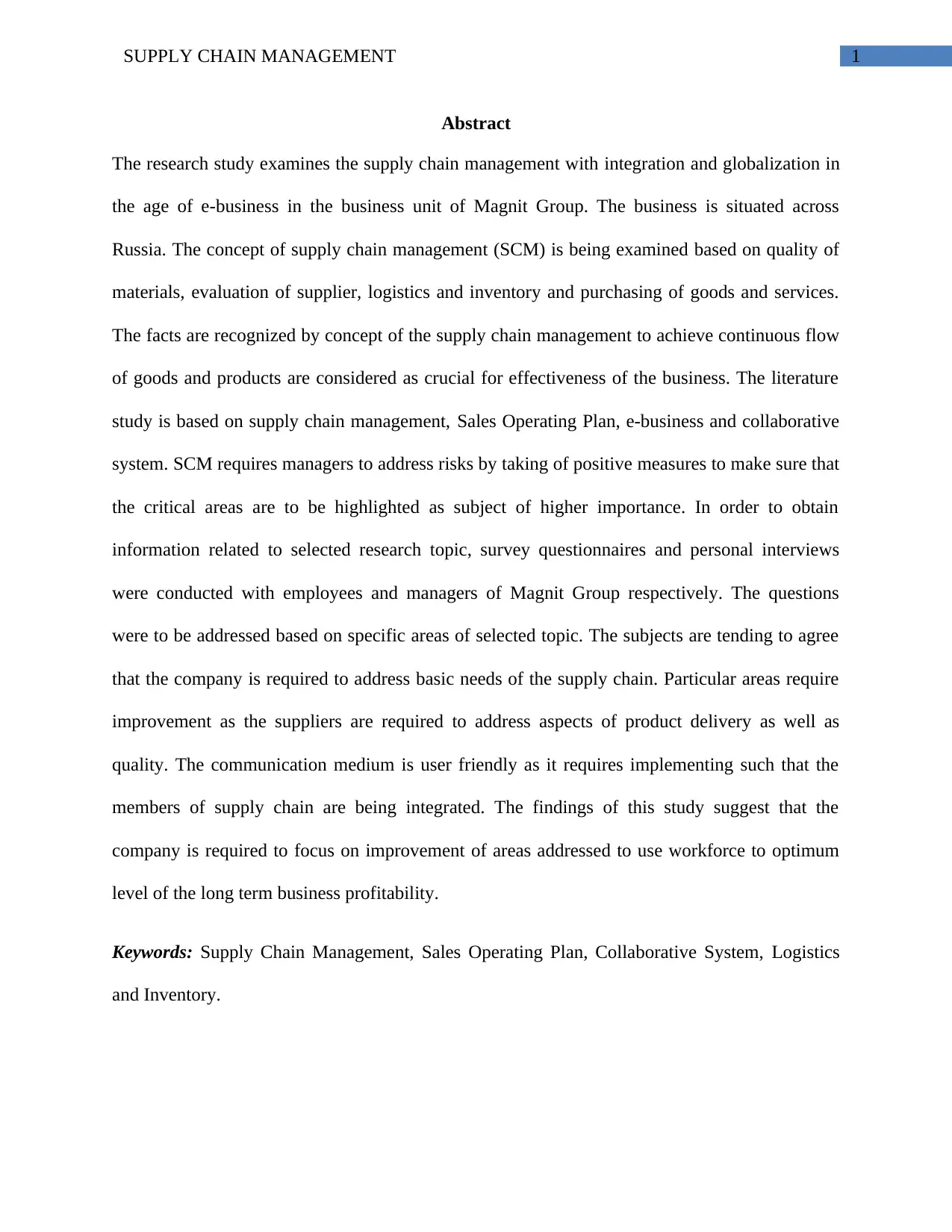
1SUPPLY CHAIN MANAGEMENT
Abstract
The research study examines the supply chain management with integration and globalization in
the age of e-business in the business unit of Magnit Group. The business is situated across
Russia. The concept of supply chain management (SCM) is being examined based on quality of
materials, evaluation of supplier, logistics and inventory and purchasing of goods and services.
The facts are recognized by concept of the supply chain management to achieve continuous flow
of goods and products are considered as crucial for effectiveness of the business. The literature
study is based on supply chain management, Sales Operating Plan, e-business and collaborative
system. SCM requires managers to address risks by taking of positive measures to make sure that
the critical areas are to be highlighted as subject of higher importance. In order to obtain
information related to selected research topic, survey questionnaires and personal interviews
were conducted with employees and managers of Magnit Group respectively. The questions
were to be addressed based on specific areas of selected topic. The subjects are tending to agree
that the company is required to address basic needs of the supply chain. Particular areas require
improvement as the suppliers are required to address aspects of product delivery as well as
quality. The communication medium is user friendly as it requires implementing such that the
members of supply chain are being integrated. The findings of this study suggest that the
company is required to focus on improvement of areas addressed to use workforce to optimum
level of the long term business profitability.
Keywords: Supply Chain Management, Sales Operating Plan, Collaborative System, Logistics
and Inventory.
Abstract
The research study examines the supply chain management with integration and globalization in
the age of e-business in the business unit of Magnit Group. The business is situated across
Russia. The concept of supply chain management (SCM) is being examined based on quality of
materials, evaluation of supplier, logistics and inventory and purchasing of goods and services.
The facts are recognized by concept of the supply chain management to achieve continuous flow
of goods and products are considered as crucial for effectiveness of the business. The literature
study is based on supply chain management, Sales Operating Plan, e-business and collaborative
system. SCM requires managers to address risks by taking of positive measures to make sure that
the critical areas are to be highlighted as subject of higher importance. In order to obtain
information related to selected research topic, survey questionnaires and personal interviews
were conducted with employees and managers of Magnit Group respectively. The questions
were to be addressed based on specific areas of selected topic. The subjects are tending to agree
that the company is required to address basic needs of the supply chain. Particular areas require
improvement as the suppliers are required to address aspects of product delivery as well as
quality. The communication medium is user friendly as it requires implementing such that the
members of supply chain are being integrated. The findings of this study suggest that the
company is required to focus on improvement of areas addressed to use workforce to optimum
level of the long term business profitability.
Keywords: Supply Chain Management, Sales Operating Plan, Collaborative System, Logistics
and Inventory.
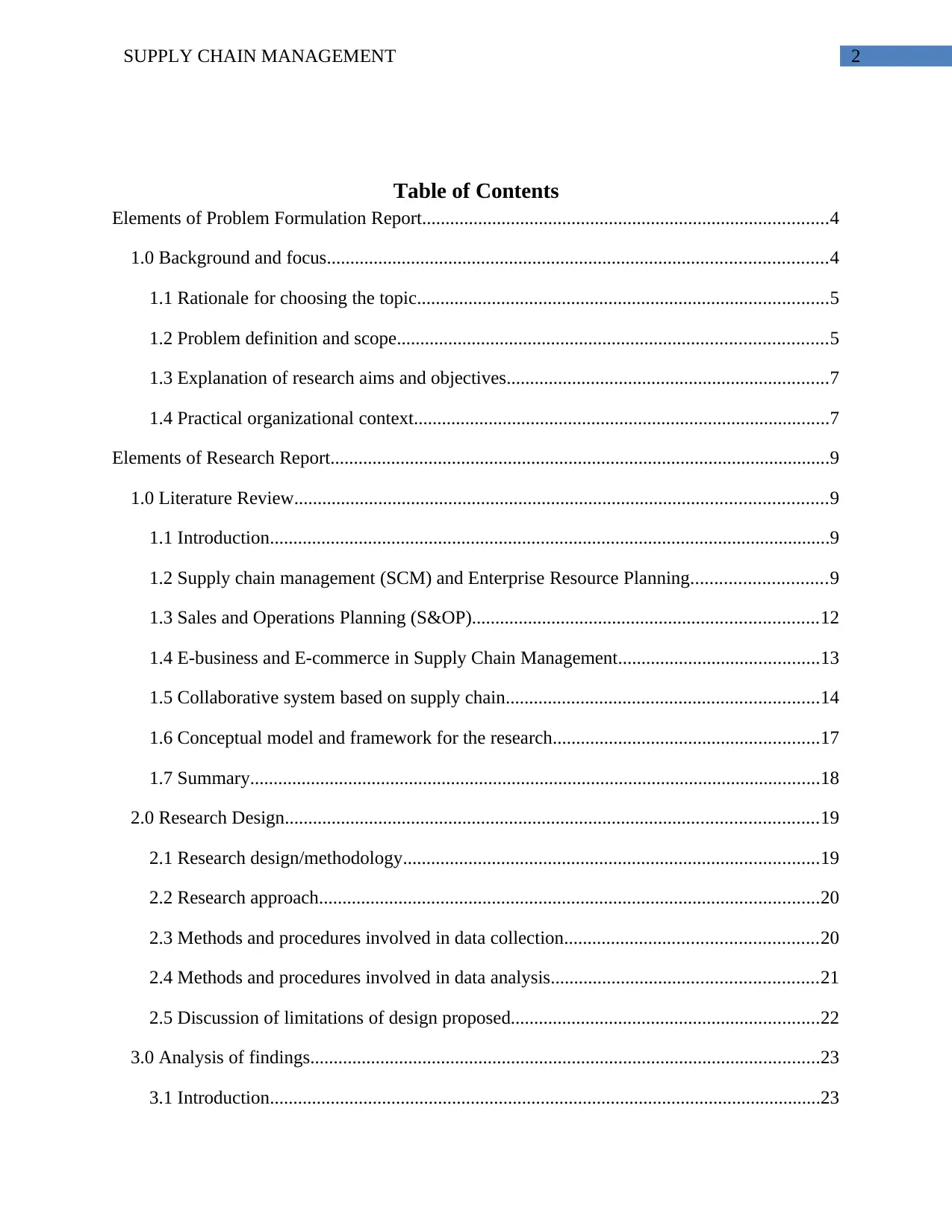
2SUPPLY CHAIN MANAGEMENT
Table of Contents
Elements of Problem Formulation Report.......................................................................................4
1.0 Background and focus...........................................................................................................4
1.1 Rationale for choosing the topic........................................................................................5
1.2 Problem definition and scope............................................................................................5
1.3 Explanation of research aims and objectives.....................................................................7
1.4 Practical organizational context.........................................................................................7
Elements of Research Report...........................................................................................................9
1.0 Literature Review..................................................................................................................9
1.1 Introduction........................................................................................................................9
1.2 Supply chain management (SCM) and Enterprise Resource Planning.............................9
1.3 Sales and Operations Planning (S&OP)..........................................................................12
1.4 E-business and E-commerce in Supply Chain Management...........................................13
1.5 Collaborative system based on supply chain...................................................................14
1.6 Conceptual model and framework for the research.........................................................17
1.7 Summary..........................................................................................................................18
2.0 Research Design..................................................................................................................19
2.1 Research design/methodology.........................................................................................19
2.2 Research approach...........................................................................................................20
2.3 Methods and procedures involved in data collection......................................................20
2.4 Methods and procedures involved in data analysis.........................................................21
2.5 Discussion of limitations of design proposed..................................................................22
3.0 Analysis of findings.............................................................................................................23
3.1 Introduction......................................................................................................................23
Table of Contents
Elements of Problem Formulation Report.......................................................................................4
1.0 Background and focus...........................................................................................................4
1.1 Rationale for choosing the topic........................................................................................5
1.2 Problem definition and scope............................................................................................5
1.3 Explanation of research aims and objectives.....................................................................7
1.4 Practical organizational context.........................................................................................7
Elements of Research Report...........................................................................................................9
1.0 Literature Review..................................................................................................................9
1.1 Introduction........................................................................................................................9
1.2 Supply chain management (SCM) and Enterprise Resource Planning.............................9
1.3 Sales and Operations Planning (S&OP)..........................................................................12
1.4 E-business and E-commerce in Supply Chain Management...........................................13
1.5 Collaborative system based on supply chain...................................................................14
1.6 Conceptual model and framework for the research.........................................................17
1.7 Summary..........................................................................................................................18
2.0 Research Design..................................................................................................................19
2.1 Research design/methodology.........................................................................................19
2.2 Research approach...........................................................................................................20
2.3 Methods and procedures involved in data collection......................................................20
2.4 Methods and procedures involved in data analysis.........................................................21
2.5 Discussion of limitations of design proposed..................................................................22
3.0 Analysis of findings.............................................................................................................23
3.1 Introduction......................................................................................................................23
⊘ This is a preview!⊘
Do you want full access?
Subscribe today to unlock all pages.

Trusted by 1+ million students worldwide
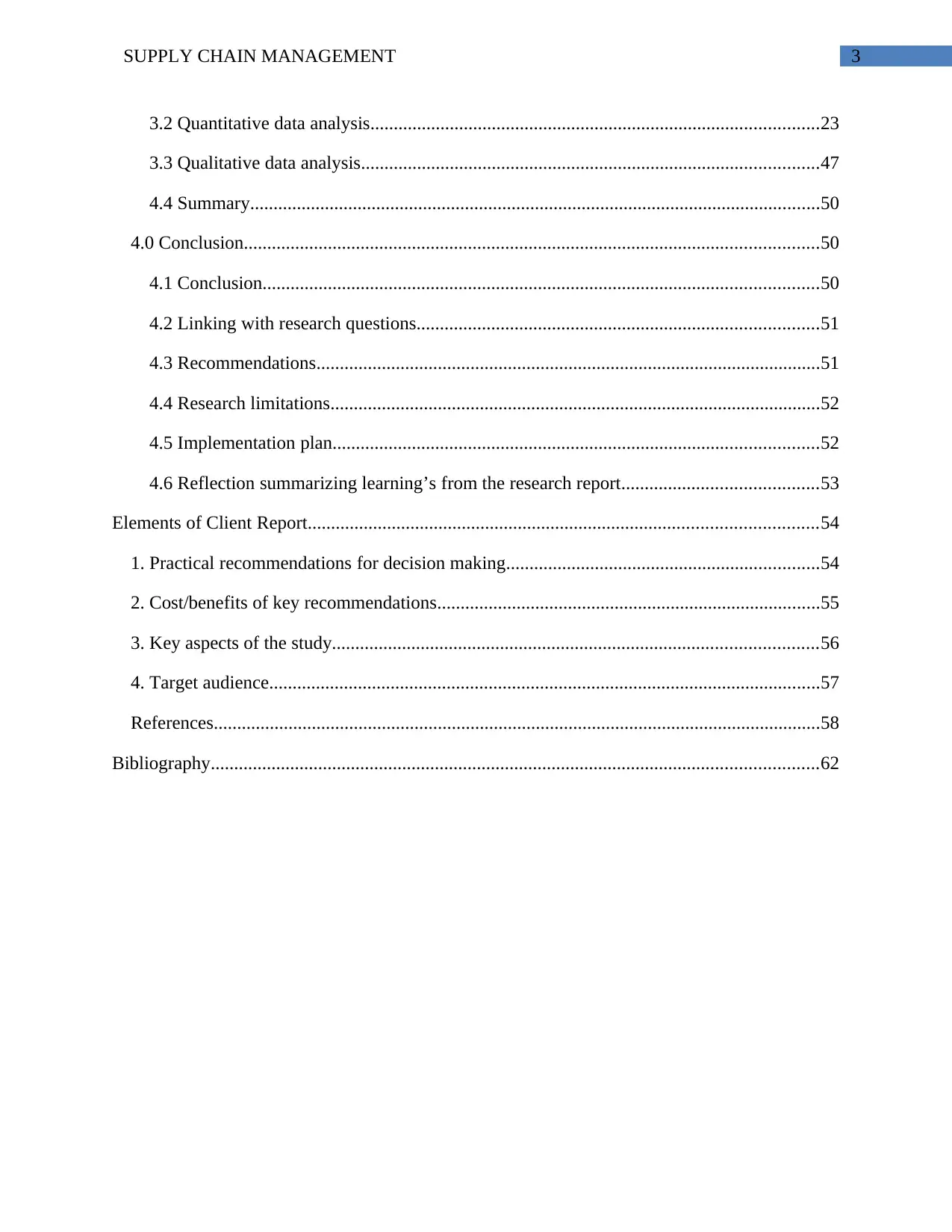
3SUPPLY CHAIN MANAGEMENT
3.2 Quantitative data analysis................................................................................................23
3.3 Qualitative data analysis..................................................................................................47
4.4 Summary..........................................................................................................................50
4.0 Conclusion...........................................................................................................................50
4.1 Conclusion.......................................................................................................................50
4.2 Linking with research questions......................................................................................51
4.3 Recommendations............................................................................................................51
4.4 Research limitations.........................................................................................................52
4.5 Implementation plan........................................................................................................52
4.6 Reflection summarizing learning’s from the research report..........................................53
Elements of Client Report.............................................................................................................54
1. Practical recommendations for decision making...................................................................54
2. Cost/benefits of key recommendations..................................................................................55
3. Key aspects of the study........................................................................................................56
4. Target audience......................................................................................................................57
References..................................................................................................................................58
Bibliography..................................................................................................................................62
3.2 Quantitative data analysis................................................................................................23
3.3 Qualitative data analysis..................................................................................................47
4.4 Summary..........................................................................................................................50
4.0 Conclusion...........................................................................................................................50
4.1 Conclusion.......................................................................................................................50
4.2 Linking with research questions......................................................................................51
4.3 Recommendations............................................................................................................51
4.4 Research limitations.........................................................................................................52
4.5 Implementation plan........................................................................................................52
4.6 Reflection summarizing learning’s from the research report..........................................53
Elements of Client Report.............................................................................................................54
1. Practical recommendations for decision making...................................................................54
2. Cost/benefits of key recommendations..................................................................................55
3. Key aspects of the study........................................................................................................56
4. Target audience......................................................................................................................57
References..................................................................................................................................58
Bibliography..................................................................................................................................62
Paraphrase This Document
Need a fresh take? Get an instant paraphrase of this document with our AI Paraphraser
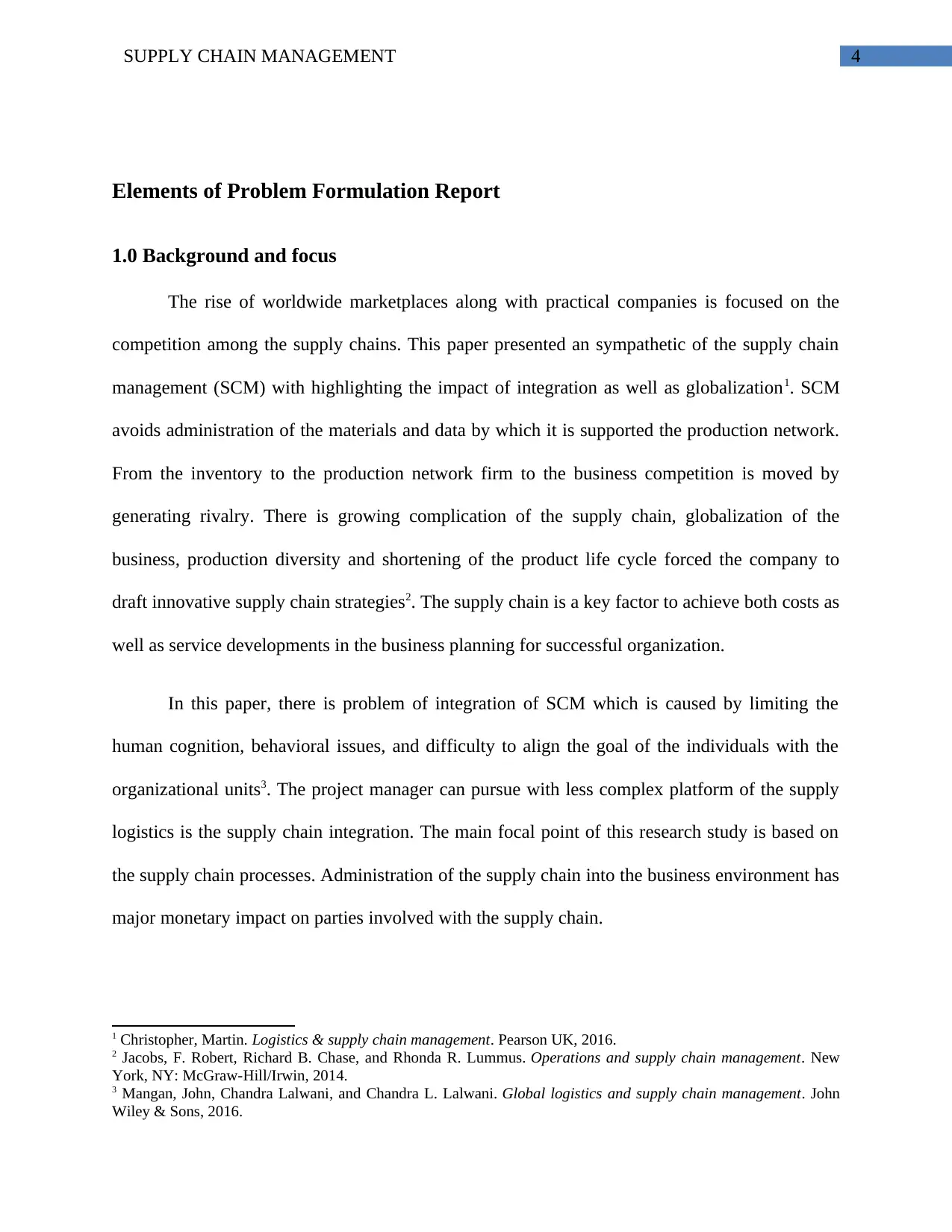
4SUPPLY CHAIN MANAGEMENT
Elements of Problem Formulation Report
1.0 Background and focus
The rise of worldwide marketplaces along with practical companies is focused on the
competition among the supply chains. This paper presented an sympathetic of the supply chain
management (SCM) with highlighting the impact of integration as well as globalization1. SCM
avoids administration of the materials and data by which it is supported the production network.
From the inventory to the production network firm to the business competition is moved by
generating rivalry. There is growing complication of the supply chain, globalization of the
business, production diversity and shortening of the product life cycle forced the company to
draft innovative supply chain strategies2. The supply chain is a key factor to achieve both costs as
well as service developments in the business planning for successful organization.
In this paper, there is problem of integration of SCM which is caused by limiting the
human cognition, behavioral issues, and difficulty to align the goal of the individuals with the
organizational units3. The project manager can pursue with less complex platform of the supply
logistics is the supply chain integration. The main focal point of this research study is based on
the supply chain processes. Administration of the supply chain into the business environment has
major monetary impact on parties involved with the supply chain.
1 Christopher, Martin. Logistics & supply chain management. Pearson UK, 2016.
2 Jacobs, F. Robert, Richard B. Chase, and Rhonda R. Lummus. Operations and supply chain management. New
York, NY: McGraw-Hill/Irwin, 2014.
3 Mangan, John, Chandra Lalwani, and Chandra L. Lalwani. Global logistics and supply chain management. John
Wiley & Sons, 2016.
Elements of Problem Formulation Report
1.0 Background and focus
The rise of worldwide marketplaces along with practical companies is focused on the
competition among the supply chains. This paper presented an sympathetic of the supply chain
management (SCM) with highlighting the impact of integration as well as globalization1. SCM
avoids administration of the materials and data by which it is supported the production network.
From the inventory to the production network firm to the business competition is moved by
generating rivalry. There is growing complication of the supply chain, globalization of the
business, production diversity and shortening of the product life cycle forced the company to
draft innovative supply chain strategies2. The supply chain is a key factor to achieve both costs as
well as service developments in the business planning for successful organization.
In this paper, there is problem of integration of SCM which is caused by limiting the
human cognition, behavioral issues, and difficulty to align the goal of the individuals with the
organizational units3. The project manager can pursue with less complex platform of the supply
logistics is the supply chain integration. The main focal point of this research study is based on
the supply chain processes. Administration of the supply chain into the business environment has
major monetary impact on parties involved with the supply chain.
1 Christopher, Martin. Logistics & supply chain management. Pearson UK, 2016.
2 Jacobs, F. Robert, Richard B. Chase, and Rhonda R. Lummus. Operations and supply chain management. New
York, NY: McGraw-Hill/Irwin, 2014.
3 Mangan, John, Chandra Lalwani, and Chandra L. Lalwani. Global logistics and supply chain management. John
Wiley & Sons, 2016.
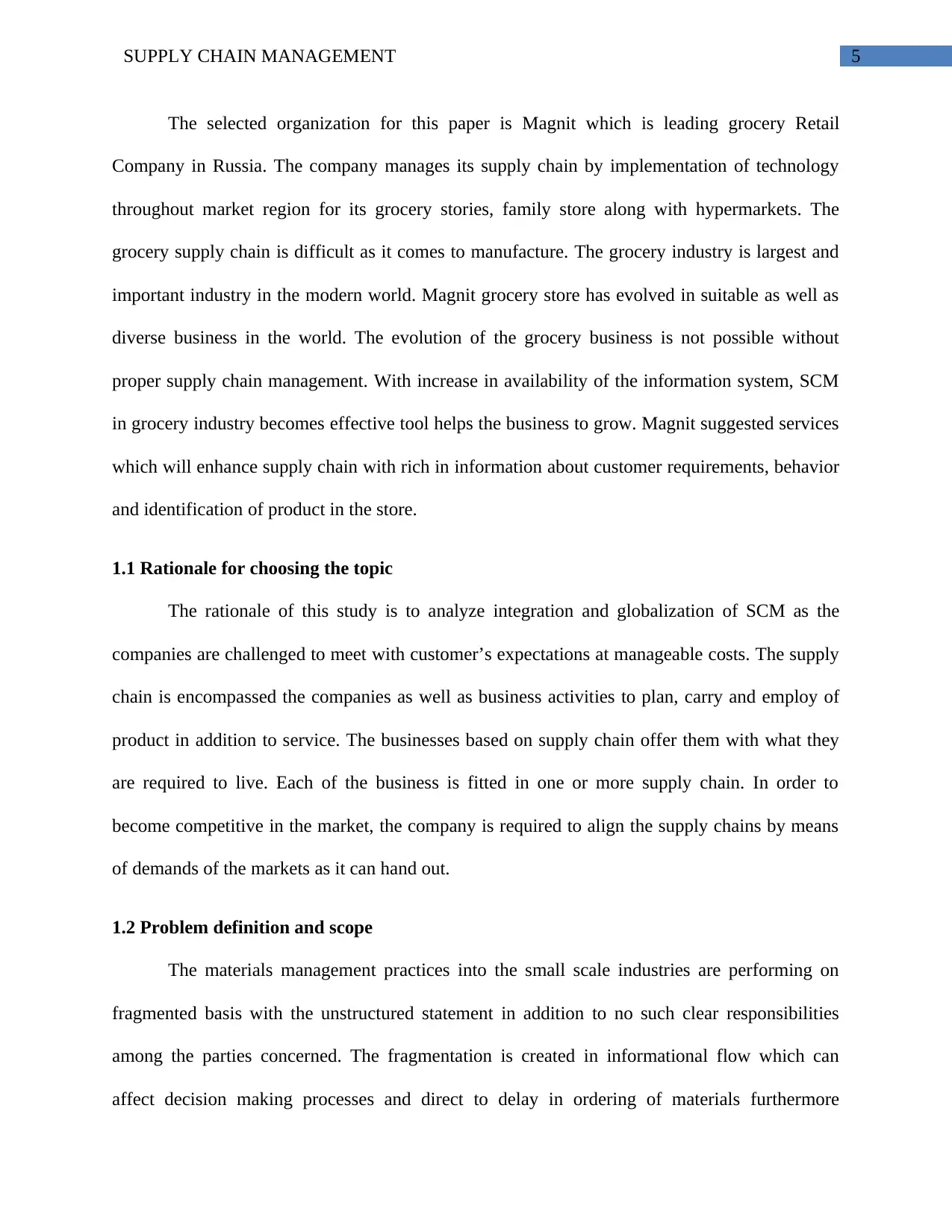
5SUPPLY CHAIN MANAGEMENT
The selected organization for this paper is Magnit which is leading grocery Retail
Company in Russia. The company manages its supply chain by implementation of technology
throughout market region for its grocery stories, family store along with hypermarkets. The
grocery supply chain is difficult as it comes to manufacture. The grocery industry is largest and
important industry in the modern world. Magnit grocery store has evolved in suitable as well as
diverse business in the world. The evolution of the grocery business is not possible without
proper supply chain management. With increase in availability of the information system, SCM
in grocery industry becomes effective tool helps the business to grow. Magnit suggested services
which will enhance supply chain with rich in information about customer requirements, behavior
and identification of product in the store.
1.1 Rationale for choosing the topic
The rationale of this study is to analyze integration and globalization of SCM as the
companies are challenged to meet with customer’s expectations at manageable costs. The supply
chain is encompassed the companies as well as business activities to plan, carry and employ of
product in addition to service. The businesses based on supply chain offer them with what they
are required to live. Each of the business is fitted in one or more supply chain. In order to
become competitive in the market, the company is required to align the supply chains by means
of demands of the markets as it can hand out.
1.2 Problem definition and scope
The materials management practices into the small scale industries are performing on
fragmented basis with the unstructured statement in addition to no such clear responsibilities
among the parties concerned. The fragmentation is created in informational flow which can
affect decision making processes and direct to delay in ordering of materials furthermore
The selected organization for this paper is Magnit which is leading grocery Retail
Company in Russia. The company manages its supply chain by implementation of technology
throughout market region for its grocery stories, family store along with hypermarkets. The
grocery supply chain is difficult as it comes to manufacture. The grocery industry is largest and
important industry in the modern world. Magnit grocery store has evolved in suitable as well as
diverse business in the world. The evolution of the grocery business is not possible without
proper supply chain management. With increase in availability of the information system, SCM
in grocery industry becomes effective tool helps the business to grow. Magnit suggested services
which will enhance supply chain with rich in information about customer requirements, behavior
and identification of product in the store.
1.1 Rationale for choosing the topic
The rationale of this study is to analyze integration and globalization of SCM as the
companies are challenged to meet with customer’s expectations at manageable costs. The supply
chain is encompassed the companies as well as business activities to plan, carry and employ of
product in addition to service. The businesses based on supply chain offer them with what they
are required to live. Each of the business is fitted in one or more supply chain. In order to
become competitive in the market, the company is required to align the supply chains by means
of demands of the markets as it can hand out.
1.2 Problem definition and scope
The materials management practices into the small scale industries are performing on
fragmented basis with the unstructured statement in addition to no such clear responsibilities
among the parties concerned. The fragmentation is created in informational flow which can
affect decision making processes and direct to delay in ordering of materials furthermore
⊘ This is a preview!⊘
Do you want full access?
Subscribe today to unlock all pages.

Trusted by 1+ million students worldwide
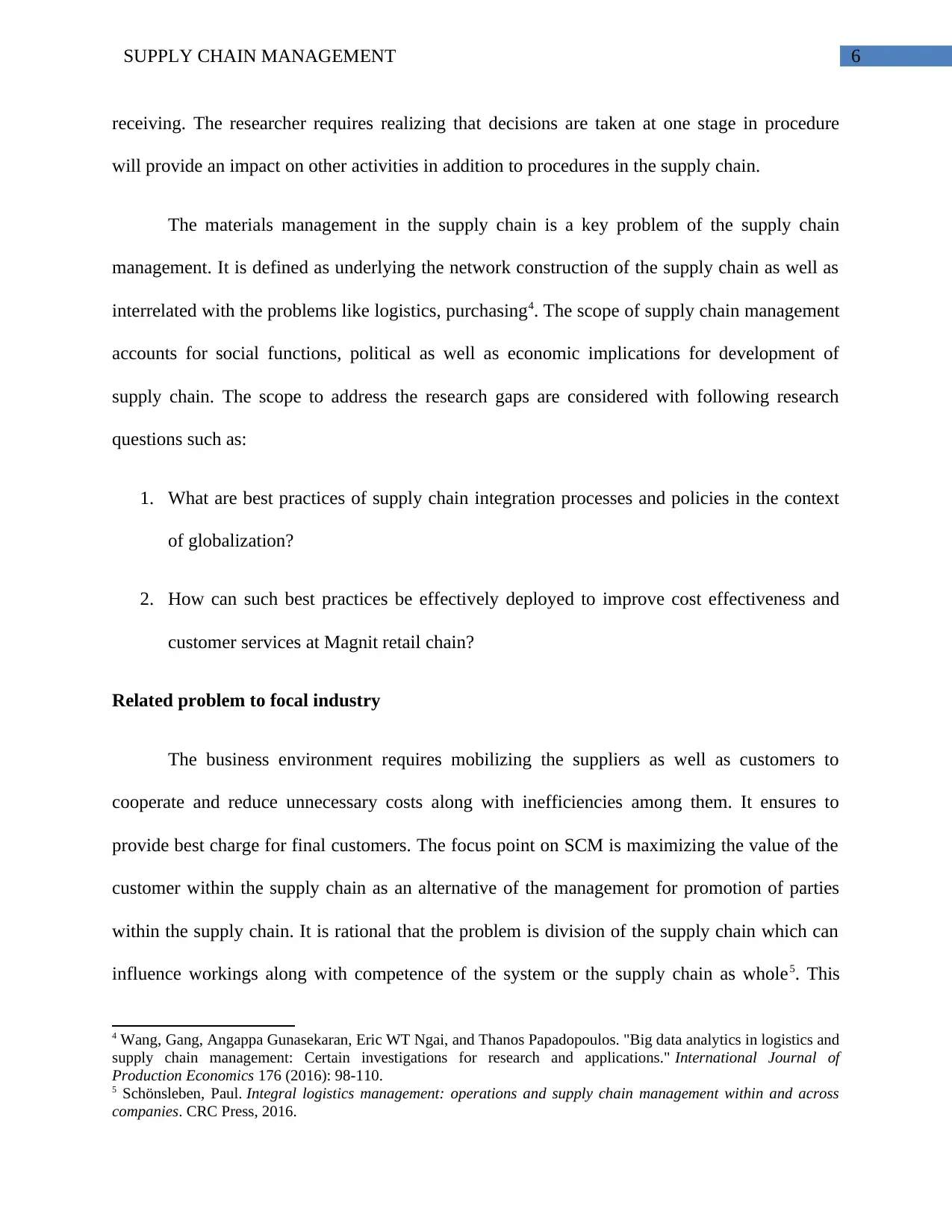
6SUPPLY CHAIN MANAGEMENT
receiving. The researcher requires realizing that decisions are taken at one stage in procedure
will provide an impact on other activities in addition to procedures in the supply chain.
The materials management in the supply chain is a key problem of the supply chain
management. It is defined as underlying the network construction of the supply chain as well as
interrelated with the problems like logistics, purchasing4. The scope of supply chain management
accounts for social functions, political as well as economic implications for development of
supply chain. The scope to address the research gaps are considered with following research
questions such as:
1. What are best practices of supply chain integration processes and policies in the context
of globalization?
2. How can such best practices be effectively deployed to improve cost effectiveness and
customer services at Magnit retail chain?
Related problem to focal industry
The business environment requires mobilizing the suppliers as well as customers to
cooperate and reduce unnecessary costs along with inefficiencies among them. It ensures to
provide best charge for final customers. The focus point on SCM is maximizing the value of the
customer within the supply chain as an alternative of the management for promotion of parties
within the supply chain. It is rational that the problem is division of the supply chain which can
influence workings along with competence of the system or the supply chain as whole5. This
4 Wang, Gang, Angappa Gunasekaran, Eric WT Ngai, and Thanos Papadopoulos. "Big data analytics in logistics and
supply chain management: Certain investigations for research and applications." International Journal of
Production Economics 176 (2016): 98-110.
5 Schönsleben, Paul. Integral logistics management: operations and supply chain management within and across
companies. CRC Press, 2016.
receiving. The researcher requires realizing that decisions are taken at one stage in procedure
will provide an impact on other activities in addition to procedures in the supply chain.
The materials management in the supply chain is a key problem of the supply chain
management. It is defined as underlying the network construction of the supply chain as well as
interrelated with the problems like logistics, purchasing4. The scope of supply chain management
accounts for social functions, political as well as economic implications for development of
supply chain. The scope to address the research gaps are considered with following research
questions such as:
1. What are best practices of supply chain integration processes and policies in the context
of globalization?
2. How can such best practices be effectively deployed to improve cost effectiveness and
customer services at Magnit retail chain?
Related problem to focal industry
The business environment requires mobilizing the suppliers as well as customers to
cooperate and reduce unnecessary costs along with inefficiencies among them. It ensures to
provide best charge for final customers. The focus point on SCM is maximizing the value of the
customer within the supply chain as an alternative of the management for promotion of parties
within the supply chain. It is rational that the problem is division of the supply chain which can
influence workings along with competence of the system or the supply chain as whole5. This
4 Wang, Gang, Angappa Gunasekaran, Eric WT Ngai, and Thanos Papadopoulos. "Big data analytics in logistics and
supply chain management: Certain investigations for research and applications." International Journal of
Production Economics 176 (2016): 98-110.
5 Schönsleben, Paul. Integral logistics management: operations and supply chain management within and across
companies. CRC Press, 2016.
Paraphrase This Document
Need a fresh take? Get an instant paraphrase of this document with our AI Paraphraser
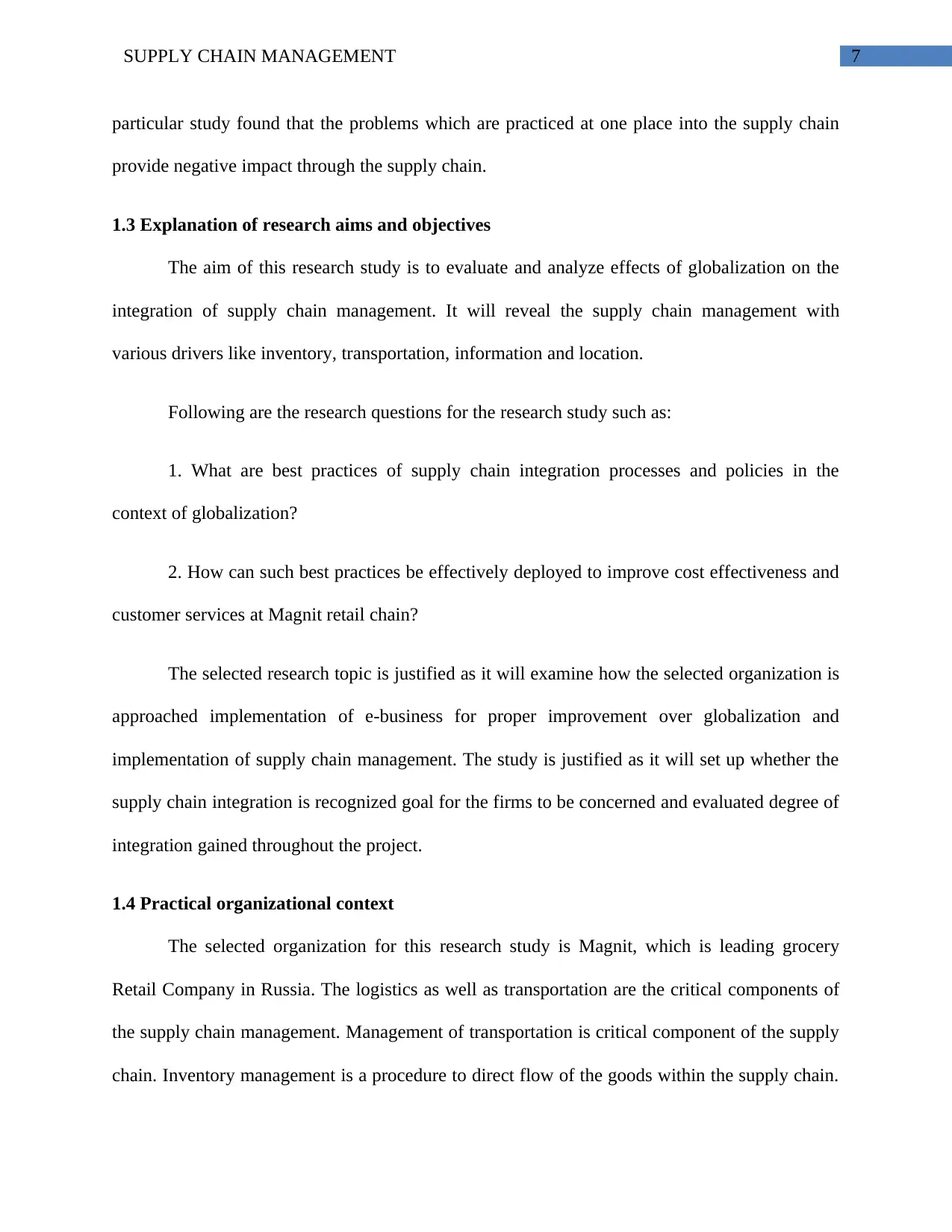
7SUPPLY CHAIN MANAGEMENT
particular study found that the problems which are practiced at one place into the supply chain
provide negative impact through the supply chain.
1.3 Explanation of research aims and objectives
The aim of this research study is to evaluate and analyze effects of globalization on the
integration of supply chain management. It will reveal the supply chain management with
various drivers like inventory, transportation, information and location.
Following are the research questions for the research study such as:
1. What are best practices of supply chain integration processes and policies in the
context of globalization?
2. How can such best practices be effectively deployed to improve cost effectiveness and
customer services at Magnit retail chain?
The selected research topic is justified as it will examine how the selected organization is
approached implementation of e-business for proper improvement over globalization and
implementation of supply chain management. The study is justified as it will set up whether the
supply chain integration is recognized goal for the firms to be concerned and evaluated degree of
integration gained throughout the project.
1.4 Practical organizational context
The selected organization for this research study is Magnit, which is leading grocery
Retail Company in Russia. The logistics as well as transportation are the critical components of
the supply chain management. Management of transportation is critical component of the supply
chain. Inventory management is a procedure to direct flow of the goods within the supply chain.
particular study found that the problems which are practiced at one place into the supply chain
provide negative impact through the supply chain.
1.3 Explanation of research aims and objectives
The aim of this research study is to evaluate and analyze effects of globalization on the
integration of supply chain management. It will reveal the supply chain management with
various drivers like inventory, transportation, information and location.
Following are the research questions for the research study such as:
1. What are best practices of supply chain integration processes and policies in the
context of globalization?
2. How can such best practices be effectively deployed to improve cost effectiveness and
customer services at Magnit retail chain?
The selected research topic is justified as it will examine how the selected organization is
approached implementation of e-business for proper improvement over globalization and
implementation of supply chain management. The study is justified as it will set up whether the
supply chain integration is recognized goal for the firms to be concerned and evaluated degree of
integration gained throughout the project.
1.4 Practical organizational context
The selected organization for this research study is Magnit, which is leading grocery
Retail Company in Russia. The logistics as well as transportation are the critical components of
the supply chain management. Management of transportation is critical component of the supply
chain. Inventory management is a procedure to direct flow of the goods within the supply chain.
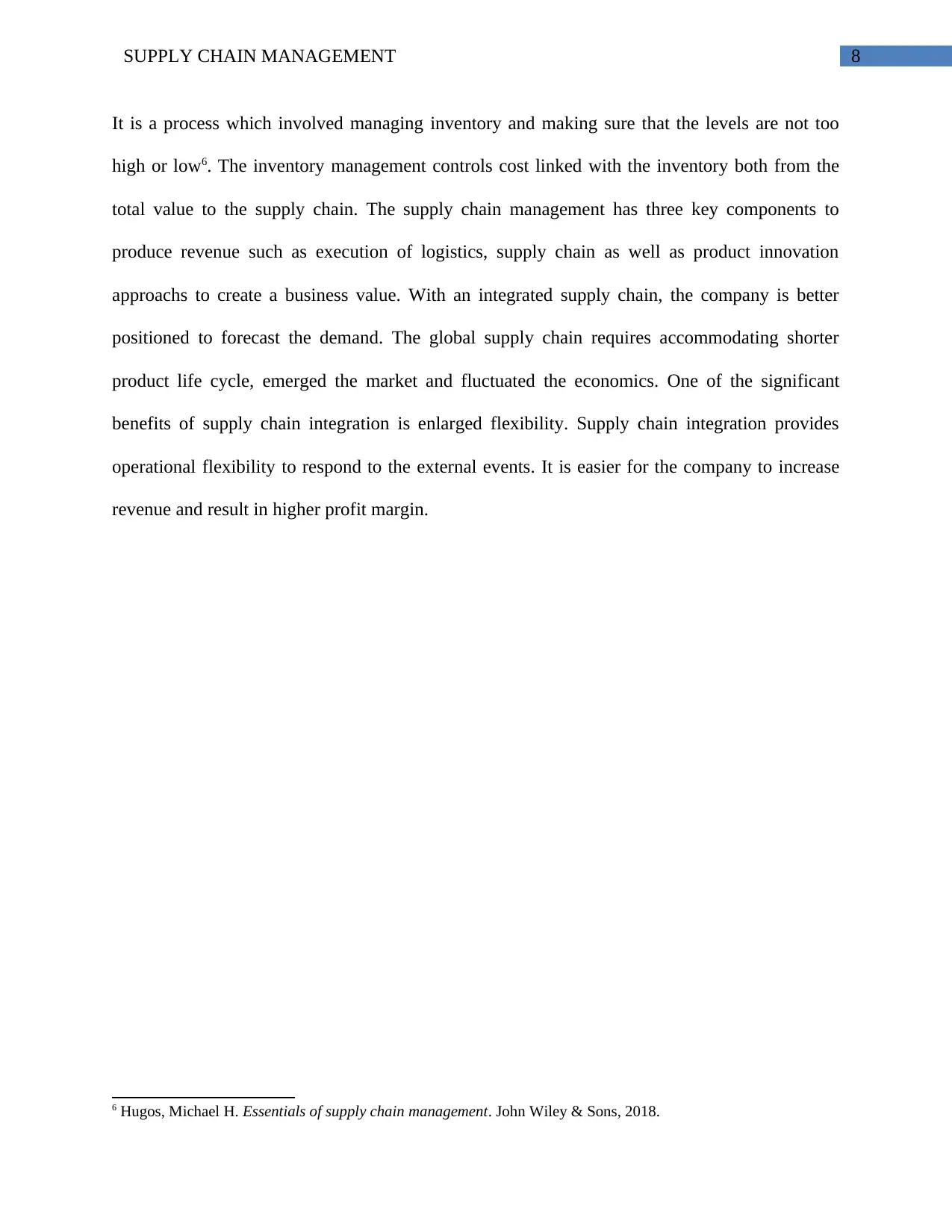
8SUPPLY CHAIN MANAGEMENT
It is a process which involved managing inventory and making sure that the levels are not too
high or low6. The inventory management controls cost linked with the inventory both from the
total value to the supply chain. The supply chain management has three key components to
produce revenue such as execution of logistics, supply chain as well as product innovation
approachs to create a business value. With an integrated supply chain, the company is better
positioned to forecast the demand. The global supply chain requires accommodating shorter
product life cycle, emerged the market and fluctuated the economics. One of the significant
benefits of supply chain integration is enlarged flexibility. Supply chain integration provides
operational flexibility to respond to the external events. It is easier for the company to increase
revenue and result in higher profit margin.
6 Hugos, Michael H. Essentials of supply chain management. John Wiley & Sons, 2018.
It is a process which involved managing inventory and making sure that the levels are not too
high or low6. The inventory management controls cost linked with the inventory both from the
total value to the supply chain. The supply chain management has three key components to
produce revenue such as execution of logistics, supply chain as well as product innovation
approachs to create a business value. With an integrated supply chain, the company is better
positioned to forecast the demand. The global supply chain requires accommodating shorter
product life cycle, emerged the market and fluctuated the economics. One of the significant
benefits of supply chain integration is enlarged flexibility. Supply chain integration provides
operational flexibility to respond to the external events. It is easier for the company to increase
revenue and result in higher profit margin.
6 Hugos, Michael H. Essentials of supply chain management. John Wiley & Sons, 2018.
⊘ This is a preview!⊘
Do you want full access?
Subscribe today to unlock all pages.

Trusted by 1+ million students worldwide
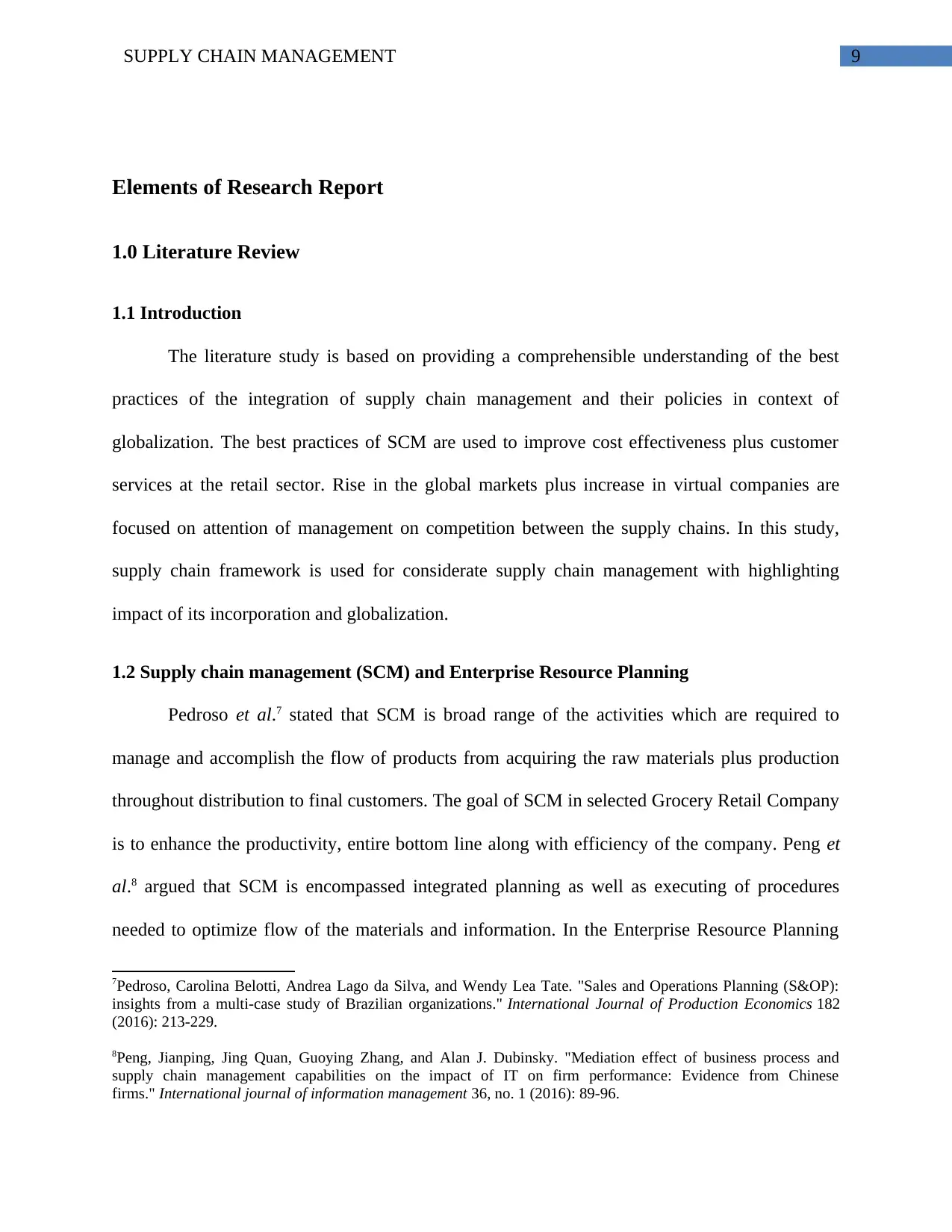
9SUPPLY CHAIN MANAGEMENT
Elements of Research Report
1.0 Literature Review
1.1 Introduction
The literature study is based on providing a comprehensible understanding of the best
practices of the integration of supply chain management and their policies in context of
globalization. The best practices of SCM are used to improve cost effectiveness plus customer
services at the retail sector. Rise in the global markets plus increase in virtual companies are
focused on attention of management on competition between the supply chains. In this study,
supply chain framework is used for considerate supply chain management with highlighting
impact of its incorporation and globalization.
1.2 Supply chain management (SCM) and Enterprise Resource Planning
Pedroso et al.7 stated that SCM is broad range of the activities which are required to
manage and accomplish the flow of products from acquiring the raw materials plus production
throughout distribution to final customers. The goal of SCM in selected Grocery Retail Company
is to enhance the productivity, entire bottom line along with efficiency of the company. Peng et
al.8 argued that SCM is encompassed integrated planning as well as executing of procedures
needed to optimize flow of the materials and information. In the Enterprise Resource Planning
7Pedroso, Carolina Belotti, Andrea Lago da Silva, and Wendy Lea Tate. "Sales and Operations Planning (S&OP):
insights from a multi-case study of Brazilian organizations." International Journal of Production Economics 182
(2016): 213-229.
8Peng, Jianping, Jing Quan, Guoying Zhang, and Alan J. Dubinsky. "Mediation effect of business process and
supply chain management capabilities on the impact of IT on firm performance: Evidence from Chinese
firms." International journal of information management 36, no. 1 (2016): 89-96.
Elements of Research Report
1.0 Literature Review
1.1 Introduction
The literature study is based on providing a comprehensible understanding of the best
practices of the integration of supply chain management and their policies in context of
globalization. The best practices of SCM are used to improve cost effectiveness plus customer
services at the retail sector. Rise in the global markets plus increase in virtual companies are
focused on attention of management on competition between the supply chains. In this study,
supply chain framework is used for considerate supply chain management with highlighting
impact of its incorporation and globalization.
1.2 Supply chain management (SCM) and Enterprise Resource Planning
Pedroso et al.7 stated that SCM is broad range of the activities which are required to
manage and accomplish the flow of products from acquiring the raw materials plus production
throughout distribution to final customers. The goal of SCM in selected Grocery Retail Company
is to enhance the productivity, entire bottom line along with efficiency of the company. Peng et
al.8 argued that SCM is encompassed integrated planning as well as executing of procedures
needed to optimize flow of the materials and information. In the Enterprise Resource Planning
7Pedroso, Carolina Belotti, Andrea Lago da Silva, and Wendy Lea Tate. "Sales and Operations Planning (S&OP):
insights from a multi-case study of Brazilian organizations." International Journal of Production Economics 182
(2016): 213-229.
8Peng, Jianping, Jing Quan, Guoying Zhang, and Alan J. Dubinsky. "Mediation effect of business process and
supply chain management capabilities on the impact of IT on firm performance: Evidence from Chinese
firms." International journal of information management 36, no. 1 (2016): 89-96.
Paraphrase This Document
Need a fresh take? Get an instant paraphrase of this document with our AI Paraphraser
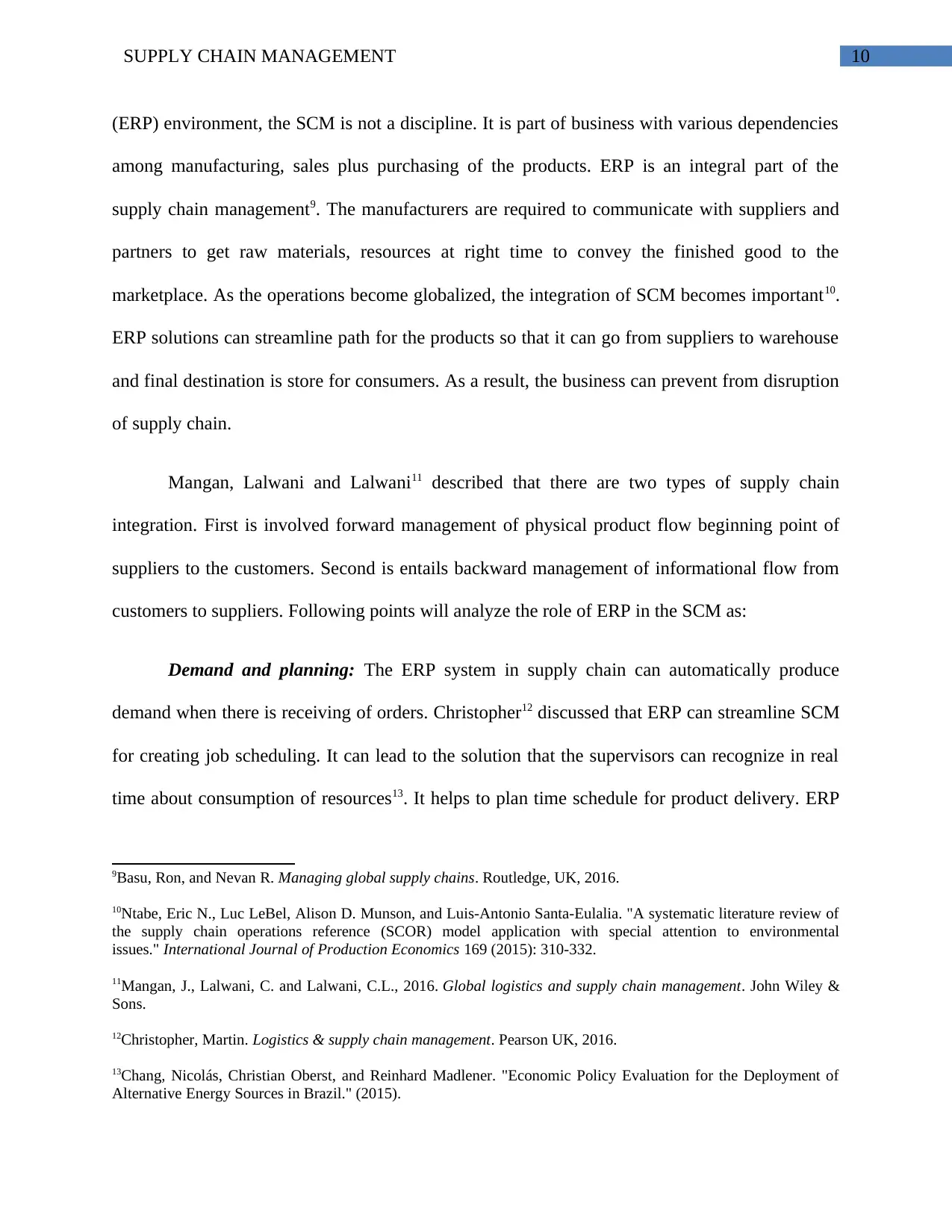
10SUPPLY CHAIN MANAGEMENT
(ERP) environment, the SCM is not a discipline. It is part of business with various dependencies
among manufacturing, sales plus purchasing of the products. ERP is an integral part of the
supply chain management9. The manufacturers are required to communicate with suppliers and
partners to get raw materials, resources at right time to convey the finished good to the
marketplace. As the operations become globalized, the integration of SCM becomes important10.
ERP solutions can streamline path for the products so that it can go from suppliers to warehouse
and final destination is store for consumers. As a result, the business can prevent from disruption
of supply chain.
Mangan, Lalwani and Lalwani11 described that there are two types of supply chain
integration. First is involved forward management of physical product flow beginning point of
suppliers to the customers. Second is entails backward management of informational flow from
customers to suppliers. Following points will analyze the role of ERP in the SCM as:
Demand and planning: The ERP system in supply chain can automatically produce
demand when there is receiving of orders. Christopher12 discussed that ERP can streamline SCM
for creating job scheduling. It can lead to the solution that the supervisors can recognize in real
time about consumption of resources13. It helps to plan time schedule for product delivery. ERP
9Basu, Ron, and Nevan R. Managing global supply chains. Routledge, UK, 2016.
10Ntabe, Eric N., Luc LeBel, Alison D. Munson, and Luis-Antonio Santa-Eulalia. "A systematic literature review of
the supply chain operations reference (SCOR) model application with special attention to environmental
issues." International Journal of Production Economics 169 (2015): 310-332.
11Mangan, J., Lalwani, C. and Lalwani, C.L., 2016. Global logistics and supply chain management. John Wiley &
Sons.
12Christopher, Martin. Logistics & supply chain management. Pearson UK, 2016.
13Chang, Nicolás, Christian Oberst, and Reinhard Madlener. "Economic Policy Evaluation for the Deployment of
Alternative Energy Sources in Brazil." (2015).
(ERP) environment, the SCM is not a discipline. It is part of business with various dependencies
among manufacturing, sales plus purchasing of the products. ERP is an integral part of the
supply chain management9. The manufacturers are required to communicate with suppliers and
partners to get raw materials, resources at right time to convey the finished good to the
marketplace. As the operations become globalized, the integration of SCM becomes important10.
ERP solutions can streamline path for the products so that it can go from suppliers to warehouse
and final destination is store for consumers. As a result, the business can prevent from disruption
of supply chain.
Mangan, Lalwani and Lalwani11 described that there are two types of supply chain
integration. First is involved forward management of physical product flow beginning point of
suppliers to the customers. Second is entails backward management of informational flow from
customers to suppliers. Following points will analyze the role of ERP in the SCM as:
Demand and planning: The ERP system in supply chain can automatically produce
demand when there is receiving of orders. Christopher12 discussed that ERP can streamline SCM
for creating job scheduling. It can lead to the solution that the supervisors can recognize in real
time about consumption of resources13. It helps to plan time schedule for product delivery. ERP
9Basu, Ron, and Nevan R. Managing global supply chains. Routledge, UK, 2016.
10Ntabe, Eric N., Luc LeBel, Alison D. Munson, and Luis-Antonio Santa-Eulalia. "A systematic literature review of
the supply chain operations reference (SCOR) model application with special attention to environmental
issues." International Journal of Production Economics 169 (2015): 310-332.
11Mangan, J., Lalwani, C. and Lalwani, C.L., 2016. Global logistics and supply chain management. John Wiley &
Sons.
12Christopher, Martin. Logistics & supply chain management. Pearson UK, 2016.
13Chang, Nicolás, Christian Oberst, and Reinhard Madlener. "Economic Policy Evaluation for the Deployment of
Alternative Energy Sources in Brazil." (2015).
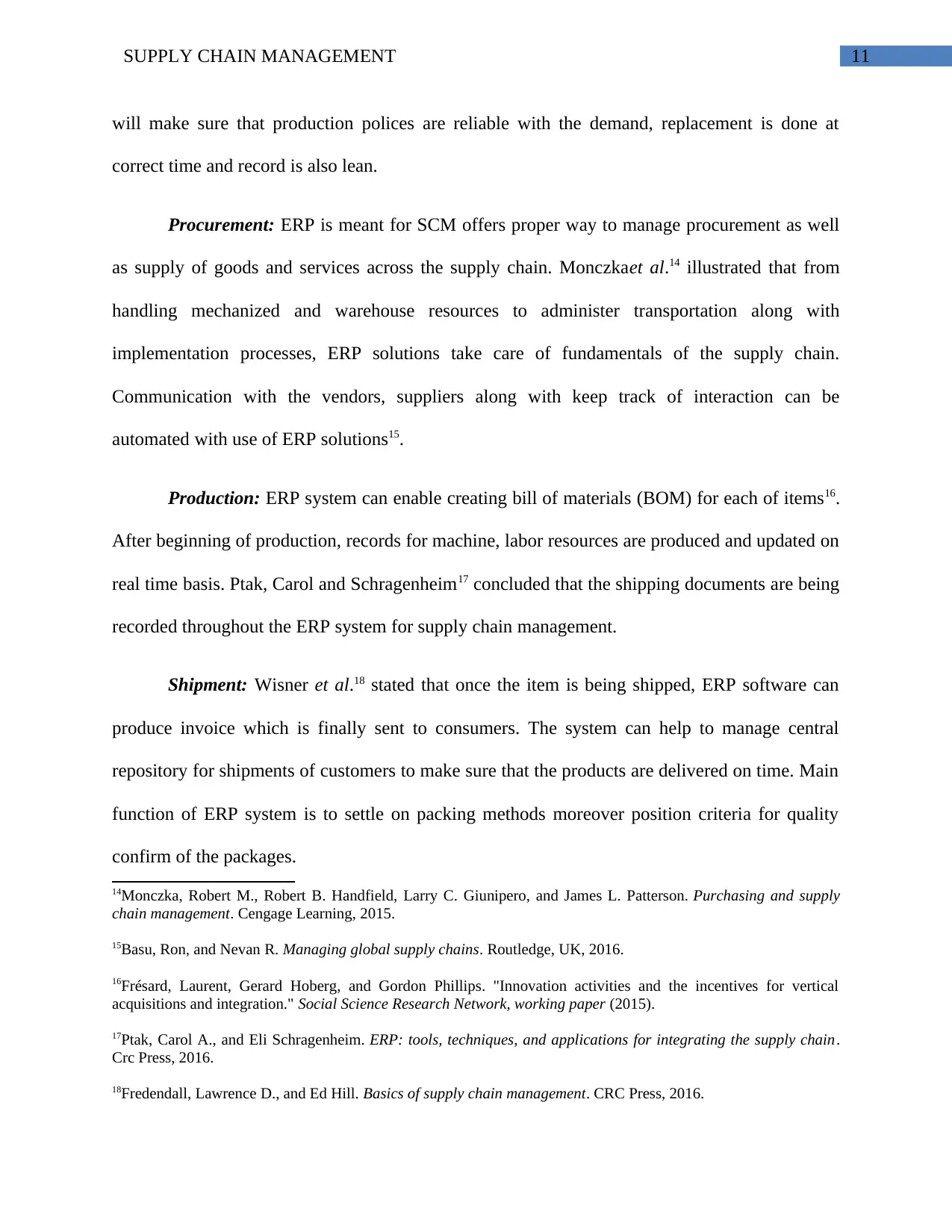
11SUPPLY CHAIN MANAGEMENT
will make sure that production polices are reliable with the demand, replacement is done at
correct time and record is also lean.
Procurement: ERP is meant for SCM offers proper way to manage procurement as well
as supply of goods and services across the supply chain. Monczkaet al.14 illustrated that from
handling mechanized and warehouse resources to administer transportation along with
implementation processes, ERP solutions take care of fundamentals of the supply chain.
Communication with the vendors, suppliers along with keep track of interaction can be
automated with use of ERP solutions15.
Production: ERP system can enable creating bill of materials (BOM) for each of items16.
After beginning of production, records for machine, labor resources are produced and updated on
real time basis. Ptak, Carol and Schragenheim17 concluded that the shipping documents are being
recorded throughout the ERP system for supply chain management.
Shipment: Wisner et al.18 stated that once the item is being shipped, ERP software can
produce invoice which is finally sent to consumers. The system can help to manage central
repository for shipments of customers to make sure that the products are delivered on time. Main
function of ERP system is to settle on packing methods moreover position criteria for quality
confirm of the packages.
14Monczka, Robert M., Robert B. Handfield, Larry C. Giunipero, and James L. Patterson. Purchasing and supply
chain management. Cengage Learning, 2015.
15Basu, Ron, and Nevan R. Managing global supply chains. Routledge, UK, 2016.
16Frésard, Laurent, Gerard Hoberg, and Gordon Phillips. "Innovation activities and the incentives for vertical
acquisitions and integration." Social Science Research Network, working paper (2015).
17Ptak, Carol A., and Eli Schragenheim. ERP: tools, techniques, and applications for integrating the supply chain.
Crc Press, 2016.
18Fredendall, Lawrence D., and Ed Hill. Basics of supply chain management. CRC Press, 2016.
will make sure that production polices are reliable with the demand, replacement is done at
correct time and record is also lean.
Procurement: ERP is meant for SCM offers proper way to manage procurement as well
as supply of goods and services across the supply chain. Monczkaet al.14 illustrated that from
handling mechanized and warehouse resources to administer transportation along with
implementation processes, ERP solutions take care of fundamentals of the supply chain.
Communication with the vendors, suppliers along with keep track of interaction can be
automated with use of ERP solutions15.
Production: ERP system can enable creating bill of materials (BOM) for each of items16.
After beginning of production, records for machine, labor resources are produced and updated on
real time basis. Ptak, Carol and Schragenheim17 concluded that the shipping documents are being
recorded throughout the ERP system for supply chain management.
Shipment: Wisner et al.18 stated that once the item is being shipped, ERP software can
produce invoice which is finally sent to consumers. The system can help to manage central
repository for shipments of customers to make sure that the products are delivered on time. Main
function of ERP system is to settle on packing methods moreover position criteria for quality
confirm of the packages.
14Monczka, Robert M., Robert B. Handfield, Larry C. Giunipero, and James L. Patterson. Purchasing and supply
chain management. Cengage Learning, 2015.
15Basu, Ron, and Nevan R. Managing global supply chains. Routledge, UK, 2016.
16Frésard, Laurent, Gerard Hoberg, and Gordon Phillips. "Innovation activities and the incentives for vertical
acquisitions and integration." Social Science Research Network, working paper (2015).
17Ptak, Carol A., and Eli Schragenheim. ERP: tools, techniques, and applications for integrating the supply chain.
Crc Press, 2016.
18Fredendall, Lawrence D., and Ed Hill. Basics of supply chain management. CRC Press, 2016.
⊘ This is a preview!⊘
Do you want full access?
Subscribe today to unlock all pages.

Trusted by 1+ million students worldwide
1 out of 63
Related Documents
Your All-in-One AI-Powered Toolkit for Academic Success.
+13062052269
info@desklib.com
Available 24*7 on WhatsApp / Email
![[object Object]](/_next/static/media/star-bottom.7253800d.svg)
Unlock your academic potential
Copyright © 2020–2025 A2Z Services. All Rights Reserved. Developed and managed by ZUCOL.




